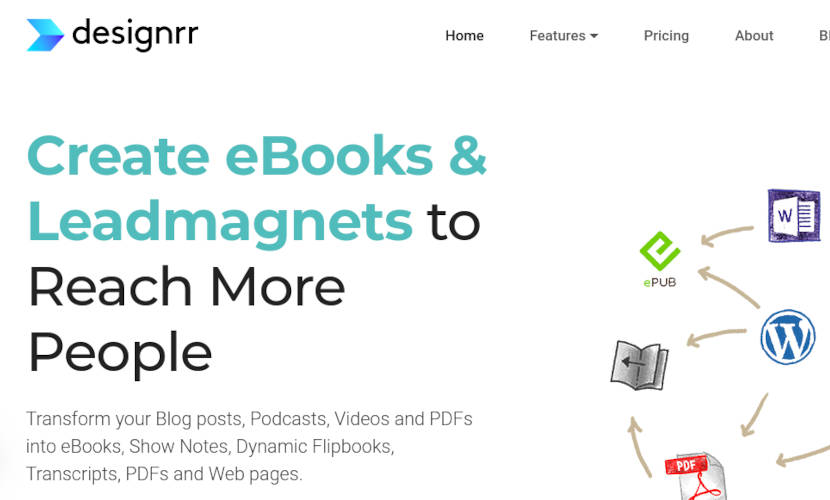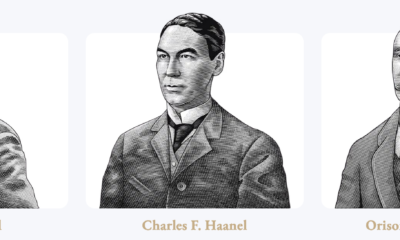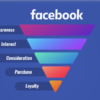Reviews
Designrr Review: A Painless Way To Create Lead Magnets To Grow Your List
Designrr Review: Everyone wants to build a bigger email list, right?
It’s great because email is a traffic source that you completely control.
Well, one of my favorite ways to grow my email list is through the use of lead magnets.
A good lead magnet can grow your email list really quickly if you put it in front of the right audience.
But the problem for most people, is that they think it’s too much effort to create a good lead magnet.
So they just don’t do it.
Enter Designrr, a really cool software that will help you make lead magnet creation so much easier by helping you to re-use content that you have already created.
It’s a huge timesaver!

Here is what I’m going to be covering in this Designrr review.
- What is Designrr?
- Who is Designrr For?
- What are the best parts about Designrr?
- What I don’t like about Designrr
- A Look Inside Designrr
- Designrr Pricing
- Final Thoughts
What Is Designrr?
Designrr is an online software platform created by Paul Clifford Bannister, and it aims to cut down the design process when it comes to creating various types of media.
These include the usual suspects:
- Blog posts
- Podcasts
- PDFs
- Ebooks
- Show notes
- Dynamic flipbooks
- Transcripts
But it’s more than just a design tool.
Designrr is primarily built and marketed as content repurposing tool, meaning it turns one type of media into another type using its import function. (More on that in a later section.)
This allows you to cut down on fresh content production and leverage your existing content in different channels.
For example:
- Turning a blog post into a PDF
- Turning a PDF into a flipbook
- Turning a podcast into a cheat sheet
- And so on…
NETWORK MARKETING SECRETS
Who Is Designrr For?
This is normally the part where I have to read between the lines and figure out what target market the product in question is focusing on.
With Designrr, however, their sales page is very clear about who should buy the product.

As you can see, you’d have to be pretty special to not fall into any of these categories being an online business.
While it’s no secret that a throwing a wide net on your target market is a bad idea, I can’t help but agree with this.
The truth is, if you do any form of content marketing, you can absolutely benefit from using Designrr as a way to reach new audiences with new, underutilized content formats.
What are the best parts about Designrr?
Best Feature #1: You can import pretty much anything
Designrr isn’t the first platform for content repurposing.
But if there’s one thing I liked about this one in particular, it’s the ability to import practically any type of media you can get your hands on.

Not only do you get your standard file uploads, but Designrr also pulls in from live pages, or social media pages such as Facebook.
The best part?
You can even import content from pages you don’t own — assuming you have permission from the content creator, of course.
Best Feature #2: You can enable free movement in the editor
Modern design tools don’t really cater for free movement design, mostly because it causes alignment issues.
That being said, there are times when you just want to place something in a specific area on the page, and Designrr allows you to do that.
It’s called ‘Free Element Dragging’ and it can enabled in the settings.

Once enabled, you can freely drag any element to any position on the page. Anyone who used GeoCities back in the day will know what this feels like. 😉
Most use-cases will involve position images, but it can be used for any element.

Best Feature #3: You can create 3D cover images
The ability to create 3D cover images is a nice little bonus feature you don’t expect from most tools in this category.
You’ll often see these used in lead magnet previews, and they can be created from your projects overview screen.
Just hover over a project and click the “3D” text to open the cover maker.
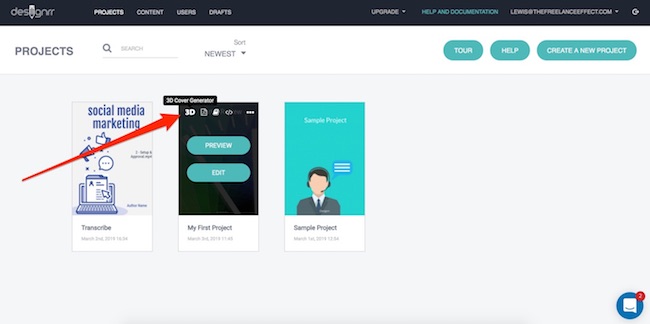
You’ll then see a popup with a few different cover style options, including paperback, hardback and flat style covers.

What I don’t like about Designrr?
Bad Part #1: No multi-select in the editor
This seems like a trivial issue but it’s one that bugged me a lot throughout my testing.
There’s no way to select multiple elements at once, whether that be by holding down a specific key or drag-selecting.
To highlight why this is an issue, check out these bullets:

To delete all those bullets, I need to select each one individually to bring up the toolbar, then click the delete icon.
Considering I have 11 bullets here, that’s 22 clicks just to remove them all. Not exactly the best UX in my opinion.
Bad Part #2: Only available as a monthly subscription
You can’t run a successful online business without tools, and tools typically come at a monthly expense.
With Designrr, however, you might only need to use it once or twice a month depending on your content schedule.
If that’s the case, you might find the ongoing cost of this one a little heavy for your taste.

Personally, I feel this is the kind of software you should be able to purchase at a one-time price, on a credit system, or even at a heavily reduced annual cost.
On the flip side, those who plan to use this regularly will find plenty of value. I just would have liked to see a friendlier option for lighter users.
A Look Inside Designrr
Getting started with Designrr is pretty straightforward. It has a nicely designed onboarding process — but there were a couple hiccups that I feel are worth pointing out.
For example, I put my credit card details in, hit submit, and was taken to a payment success page.
Except the text wasn’t even properly filled out…
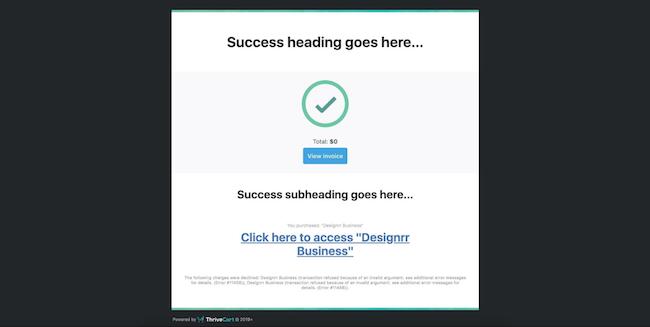
Also, you may not be able to see this from the screenshot, but the footer text actually said my card was declined, even though it wasn’t.
Not the best start, but I pushed on.
The following page (before logging in) showcases a basic walkthrough video to get you familiar with certain areas of the tool.
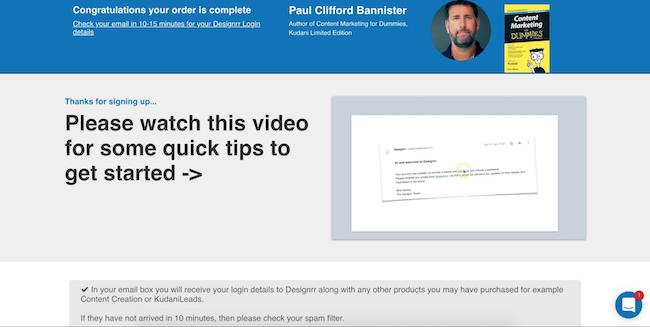
Once you receive your login link and credentials, you’ll then able to access the main Designrr dashboard where the real magic happens.
Once again, you’ll be greeted with a welcome video that goes a bit deeper into the functionality of the platform.

Closing this video then prompted a series of “tour notifications”.
At this point I just wanted to dive into the tool and start getting familiar with it, so I chose to skip the tour.

And that’s it for onboarding. This is where the fun begins.
Creating A Project
First thing you’ll want to do is create a project.
You can do so by clicking the ‘Create a New Project’ button in the top right corner.
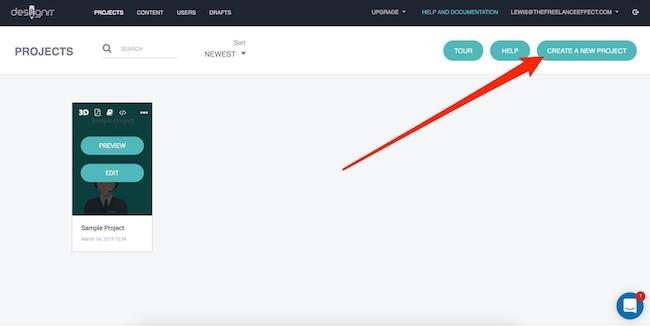
From there, Designrr will ask you to import some content so it has something to work with during the design stage.
You can import an existing file such as a Word Doc, PDF, audio clip or custom URL, or create something from scratch.

This time I decided to upload a Word Document that was drafted for our previous Kartra review.
Note: I actually wrote the review in Google Docs, so I just exported as a .doc file.
Depending on the size of your file it can be take a few minutes. Nothing out of the ordinary.
Once the import has completed, you can move on to the next step.
This stage, of course, is choosing your design style. Designrr offers over 200 different templates and layouts to get your creative juices flowing.

In terms of the designs themselves, many are repeated with minor layout changes but overall, they’re not bad.
You get a good mix of flat graphics and real-life cover photos, as well as busy or minimal design styles.
Selecting any of these templates will take you to a summary screen before you can start making changes. This is just to name your project and define the footer URL, which would typically be your website.

The next stage in the creation process is tweaking your design, so let’s talk more about that now.
The Design Editor
Having access to well-designed templates are great, but there will always be necessary changes based on the content you import.
The design editor is where you make those changes, and here’s what it looks like:

The controls work like most modern page builders. The sidebar is used to navigate to different sections of the editor, under which you’ll find related elements you can use on the page.
Designrr also supports inline editing, meaning you can click elements on the page and make changes directly.
For example, I can rewrite the title “My Ebook” by simply clicking on it and typing away.

The first page background image of a microphone also doesn’t relate to a software product review. We can fix that.
Clicking the background opens up the appropriate sidebar settings to swap it out.

I don’t have a custom cover photo for this example, so I’ll just use one of Designrr’s stock cover photos.
These are okay, but you’ll always be better off with a custom made cover.

The point is, making these changes was fast and intuitive — and that’s what you need when building lengthy ebooks with dozens or even hundreds of pages.
Moving on, let’s look at the rest of the content.
As expected, Designrr has pulled in all the content from my Word Document, along with all the correct formatting such as bullets, links and headings.
It’s not perfect, however.
For example, the font size of the bullets are noticeably larger than the rest of the body text for no apparent reason.
Fortunately, Designrr makes it super easy to apply such a typography change to all similar elements.
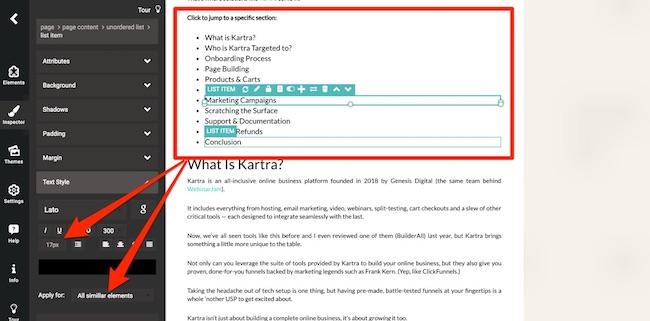
Scrolling down further, one of my main concerns was having all my images correctly imported — and as you can see, I tend use a lot of them in my reviews.
For the most part, Designrr handled this well and all my images were correctly inserted into my content. They were also all available in my image library inside Designrr.
I only noticed a few small issues with spacing between the image and body text.

This is a low effort fix, but having to check this across so many pages can be cumbersome. Not ideal.
Finally, let’s look at themes.
Themes make subtle design changes to your template, and can be selected from inside the sidebar panel.
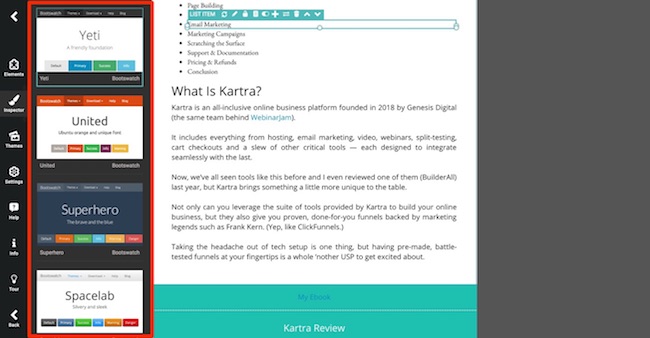
Honestly, I was left a little confused by this feature. I noticed changes to fonts and sizes, but the themes imply a color scheme change that were never carried through.
For example, choosing the dark ‘Cyborg’ theme had impact on the color scheme of my template.
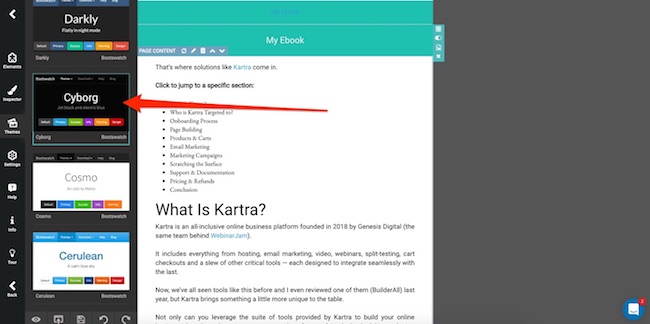
A tad confusing, right?
Fortunately, changing the color scheme can be done for specific elements, as well as globally using the ‘apply for all similar elements’ setting.

Overall, the design editor is everything you’d expect it to be, but with a few minor import and UX issues.
Thankfully nothing I’d consider a deal-breaker.
Publishing Your Design
So you’ve imported your content, tweaked your design, now you need to export the final product.
To export, you need to publish your design. And to publish your design, you need to click the publish button…
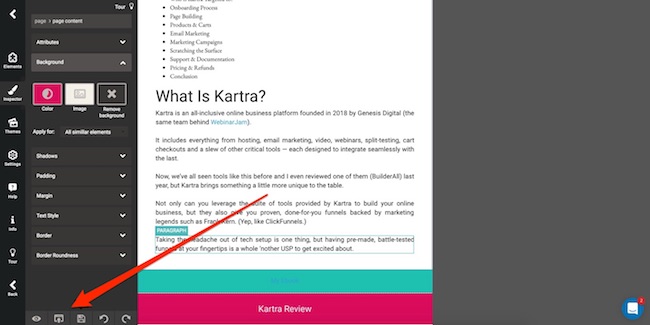
This will bring up the publishing options.
These are exporting as a PDF, mobi (Kindle), Epub, and good ol’ fashion HTML.

In this case, I chose to export as a PDF.
Designrr then gets to work generating the final product. This process can take a few minutes, but again that’s pretty normal when importing or exporting a large number of pages.
For some reason, my first attempt at exporting ended in disappointment.
After waiting patiently for the export to finish, apparently Designrr had trouble connecting to the server and aborted the process altogether.

Fortunately, this appeared to be a freak occurrence as I never had that issue afterwards.
It could well have been due to a slow or unstable internet connection, so it’s worth keeping that in mind.
Transcriptions
What I’ve covered so far is essentially Designrr in a nutshell, but the more expensive plans offer a unique feature that I think is worth talking about.
Yup, transcriptions.
This a proprietary software within the platform, which means transcriptions are super fast and no humans are involved in the process.
To test this service, I first needed to create a new project and select the audio/video content format.

I then needed to upload an audio or video clip for transcription.
Since I didn’t actually need anything transcribed, I decided to use a 7-minute clip from one of my video courses.
I felt this was a realistic sample to use because:
- The sound quality is good but not amazing.
- I talk somewhat conversationally throughout.
- I’m British, so I have a British accent.
These factors mean my transcription will reflect a genuine use-case, but it also pushes the software to work just that little bit harder.

Once your audio or video file is upload, you can click to start the transcription which will then deduct from your monthly hourly allowance.
As you can see above, the estimated transcription time was about 2 minutes and I found this to be surprisingly accurate.
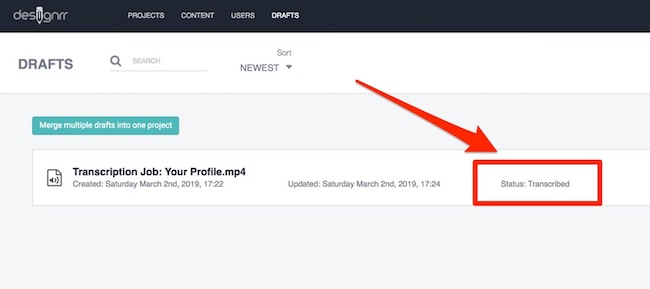
But just how good can a 2-minute generated transcription be on a 7-minute video?
I opened it up and began comparing the text to what I actually say in the video, and the result was very interesting.
The vast majority of text matched word-for-word what I say in the video, and I could only pick out a few mistakes here and there.

Admittedly, any reasonable level of grammar checking would have been able to detect these mistakes and substitute the words for the correct ones, but that might be asking a lot from a service like this.
There were also a few other small but questionable grammar mistakes such as missing commas, using periods in place of commas, and even randomly capitalized words. Oh, and it also picked up filler words.
Here’s a section that highlights some of the issues I refer to:
“So this is my profile, at least the main section of it and what you see is what we’ll be focusing on. Uh, this is the part that clients really pay attention to and it’s where most of the magic happens. So I’m going to go right in and just break this apart. The first element is the photo. And clients do look at your photo. There will form an immediate opinion is just human nature.”
Personally, I’d give the accuracy of this tool a respectable 7 out of 10.
If I were using this for real, I’d have a human editor comb through and just polish it up slightly. But of course, you may have better results with an American accent and higher audio quality.
Moving on, you may have also noticed some of my video slides were pulled into the transcription, but screenshots can be removed using the transcription tools.

These tools also allow you to download the text, export as an SRT file, and even insert further screenshots based on the slider position of the video.
Once you’re happy with the transcription, Designrr takes you through the same steps as before.

And yes, this includes the same set of templates, editor settings and export options. Everything we covered previously can be applied.
Overall, if you’re looking for a quick and easy way to repurpose your video and audio content into readable formats, it doesn’t get much easier than this.
Designrr Pricing
Designrr has 4 different pricing plans that you can sign up for.
The Std plan starts at $29 a month. Since this is the lowest end plan, you’re missing the 200 Project Templates and Export to Kindle, iBooks, ePub functionality.
For that, you’ll need to get the Pro plan which is $39 a month.
However, if you want any of the transcription services then you will need to sign up for the Premium ($49/month) which gives you 4 transcription hours or the Business plan ($99/month) which gives you 8 transcription hours. The 2 higher end plans also give you access to the FB group.
All Designrr plans come with a free 7-day trial, so you can see if it works well for what you’re trying to do.
Final Thoughts
Ideally, to grow your email list the fastest, you would create a super targeted lead magnet for every high traffic post on your site.
However not too many people will do this, because of how time consuming it would be.
But with Designrr, this all becomes possible. It makes it super easy to repurpose my content and create multiple lead magnets very fast. And that means my email list will grow even faster.
Designrr Pros
- Plenty of onboarding videos and notifications
- Basic, but intuitive user interface
- Tons of import options including various file formats
- Flexible design editor + free movement of elements
- Over 200 templates and layouts
- Multiple publishing options
- 3D cover image creator
- Software-powered transcription service
- Reliable live-chat support (even on weekends)
Designrr Cons
- No multi-select in the design editor
- Transcriptions may still require human editing
- Only available as a monthly subscription
- No mention of refunds on their pricing page or T&C’s
>>>Join The One Funnel Away Challenge<<<


